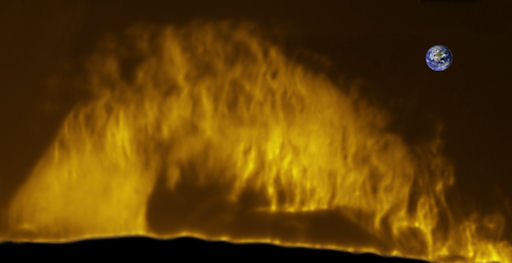MERCURY-DIRECTED CME: A significant coronal mass ejection (CME) blasted away from the sun's eastern hemisphere on Nov. 12th. Analysts at the Goddard Space Weather Lab say the cloud will hit Mercury on Nov. 13th at 1800 UT (+/- 7 hr) followed by Venus about one day later. The innermost planets are about to experience space weather. [CME: movie, forecast track]
REMARKABLE SOLAR ACTIVITY: There haven't been any strong solar flares in days. Nevertheless, some impressive activity is underway on the sun. For one thing, an enormous wall of plasma is towering over the sun's southeastern horizon. Stephen Ramsden of Atlanta, Georgia, took this picture on Nov. 11th:
"Solar forums all over the world are buzzing with Sun-stronomers proclaiming this to be the biggest prominence that many of them had ever witnessed," he says.
Remarkably, though, this is not the biggest thing. A dark filament of magnetism is snaking more than halfway around the entire sun: SDO image. From end to end, it stretches more than a million km or about three times the distance between Earth and the Moon. If the filament becomes unstable, as solar filaments are prone to do, it could collapse and hit the stellar surface below, triggering a Hyder flare. No one can say if the eruption of such a sprawling structure would be Earth directed.
"I cant help but wonder what could possibly come next since we are still over a year away from the forecasted Solar Maximum," adds Ramsden. "There's never been a better time to own a solar telescope than now!"
I don’t watch a heap of news, so I was surprised to hear that people are expecting 2012 to end thanks to a massive solar flare as a result of the oncoming solar maximum. Thankfully, even as I heard about it, I was reliably informed by scientists from NASA that such an event is a ‘physical impossibility’.
The threat of a “killer solar flare” as NASA has dubbed the worries is virtually impossible, as NASA scientists note that “there simply isn’t enough energy in the sun to send a killer fireball 93 million miles to destroy Earth.”
Nice to know, really. Though, you’d wonder at that, considering it’s, well, you know, the sun.
But with the solar cycle ramping up to the latest solar maximum, you have to remember that planet Earth has been enduring these cycles for … ever. In fact, if you’ve over the age of 11, you’ve already lived through such a solar maximum and, well, we’re all still here.
Side note – the conspiracy theorists linking the solar maximum/”killer solar flare” with the end of the Mayan calendar and our impending 2012 doom should have done their research a little better: the maximum isn’t expected to peak until the end of 2013, early 2014.
Now, let’s be fair; space weather can affect our planet. While the heat from a solar flare can’t make it all the way out to us on Earth, the electromagnetic radiation can, and does. Once reaching our atmosphere, the electromagnetic radiation “can temporarily alter the upper atmosphere creating disruptions with signal transmission from, say, a GPS satellite to Earth causing it to be off by many yards.”
Even more disruptive is the possibility of a coronal mass ejection, also known as a CME, clever hey? These solar explosions expel bursts of particles and electromagnetic fluctuations into our planet’s atmosphere where they can induce electric fluctuations at ground level that might have the power to blow out transformers in power grids.
A CME could also blow out a satellite’s internal workings.
Now sure, this provides a hazard in our very technologically-dependent world, where every other phone has a GPS device and the ability to read a map has suddenly become extinct. But, as NASA notes, “it is a problem the same way hurricanes are a problem. One can protect oneself with advance information and proper precautions.”
NASA, NOAA, and agencies throughout the world provide warnings of impending CME’s or other threats to electric companies, spacecraft operators, and airline pilots, long before they reach Earth, so that something can be done. And while we can always better improve our predicting abilities, and have done so over the past few decades, worrying about “killer solar flares” does nobody any good.
Except for me, the writer, who gets to tell you why you shouldn’t worry about “killer solar flares”.
Source: NASA SOURCE: http://spaceweather.com/ Source: Planetsave (http://s.tt/13Nxv)
You vitriolic, patriotic, slam, fight, bright light, feeling pretty psyched. It's the end of the world as we know it.


No comments:
Post a Comment